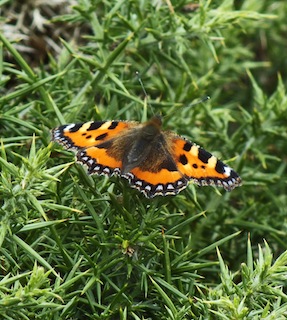 Small Tortoiseshells usually produce two broods in a year, and so a second-generation of adults emerges in August.
Small Tortoiseshells usually produce two broods in a year, and so a second-generation of adults emerges in August.
Photo: Amanda Scott
Scientific name: Aglais urticae
Cornish name: ‘Tikki-dui’ is the general word for butterfly
What to look for:
- Colouring: Orange wings with black and yellow markings, white spot on forewing, and a ring of blue spots edging both wings.
- Size: Wingspan 50 to 56 mm (females are larger than males)
- Where: Urban parks and gardens, copses, lanes and rides.
- When: From early spring (as overwintering individuals come out of hibernation) to late autumn. Hibernating butterflies might be spotted in sheds and outbuildings over the colder months.
- Similar species: Painted Lady, the much scarcer Large Tortoiseshell (now extinct in Britain)
 If you enjoy seeing colourful Small Tortoiseshell butterflies in your garden, then it’s worth having a nettle patch, as Common Nettle (Urtica dioica) and Small Nettle (U. urens) are the foodplants of the caterpillars. Look on the undersides of the upper leaves of a nettle plant in late April to May, and possibly again in July to early August (this is a two-brood butterfly), to see if you can spot any piles of small green eggs clustered together. The female will have laid these after carefully choosing a plant in a sunny spot and with plenty of young leaves for the growing caterpillars to feast upon. If you find eggs, then check again (in May/June and July/August) for the communal web of the small black larvae. You may well also see a trail of discarded webs, left behind as the larvae finish eating at one site and move on to another.
If you enjoy seeing colourful Small Tortoiseshell butterflies in your garden, then it’s worth having a nettle patch, as Common Nettle (Urtica dioica) and Small Nettle (U. urens) are the foodplants of the caterpillars. Look on the undersides of the upper leaves of a nettle plant in late April to May, and possibly again in July to early August (this is a two-brood butterfly), to see if you can spot any piles of small green eggs clustered together. The female will have laid these after carefully choosing a plant in a sunny spot and with plenty of young leaves for the growing caterpillars to feast upon. If you find eggs, then check again (in May/June and July/August) for the communal web of the small black larvae. You may well also see a trail of discarded webs, left behind as the larvae finish eating at one site and move on to another.
The caterpillars then disperse and live singly in a folded leaf until ready to pupate, which they do hanging from a stem or leaf, for two to four weeks, before emerging as the familiar orange-coloured butterflies. The underside of the adults’ wings is much plainer (see the bottom photo on this page), providing good camouflage, but the bright upper wing colouring is also a defence, signalling that they are not very tasty. Males establish territories in the afternoon, moving on to a new patch each day, waiting for passing females to court.
The second-brood adults hibernate through the winter, finding dark, cool but sheltered spots. These might include our own sheds and outbuildings, and even houses. In order to survive hibernation, the butterflies need to take on considerable energy reserves, and will therefore spend a lot of time nectaring in the summer and early autumn.
Small Tortoiseshells have a wide range, including Europe, Asia, China and Mongolia. Although a common butterfly, population levels do naturally vary. More recently this natural fluctuation has been overlain by an alarming decline in numbers, in south-east England in particular, where numbers have declined by 80% since 1990. This could be due to a number of factors, including wetter summers and a small fly, Sturmia bella, which is parasitic on the caterpillars and is increasing in the UK as a result of climate change.
Did you know…?
…As Small Tortoiseshell caterpillars are fairly visible on the nettle plants, they have evolved a few clever tricks to deter predators. These include jerking from side to side in unison, rather like an aerobics class for larvae!
…In years when conditions are particularly favourable, Small Tortoiseshells may produce a third brood.
More information and references:
Butterfly Conservation, 2011. The State of the UK’s Butterflies 2011. Butterfly Conservation, Wareham, Dorset.
Mansell, E. and Newman, L.H., 1968. The Complete British Butterflies in Colour. Ebury Press and Michael Joseph, London.
Wacher, J., Worth, J. and Spalding, A., 2003. A Cornwall Butterfly Atlas. Pisces Publications, Newbury, Berkshire.
Whalley, P. and Lewington, R., 2009. The Pocket Guide to Butterflies. Bounty Books, London.
Published: August 2014
Author: Amanda Scott
Photos: Amanda Scott
